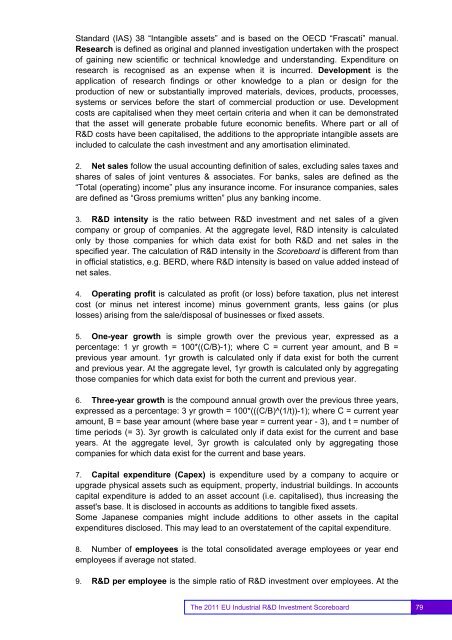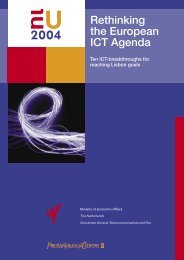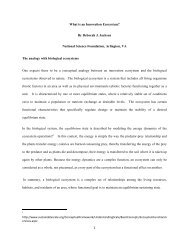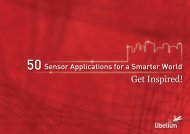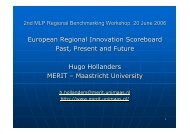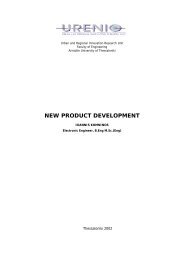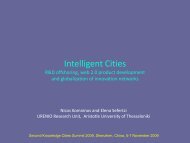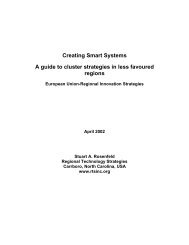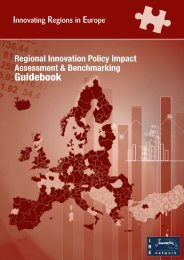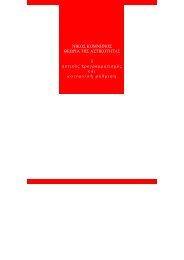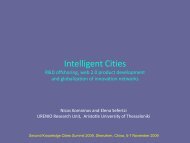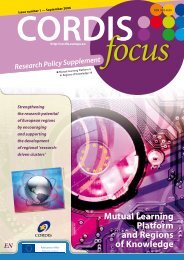EU Industrial R&D Investment Scoreboards 2011
EU Industrial R&D Investment Scoreboards 2011
EU Industrial R&D Investment Scoreboards 2011
Create successful ePaper yourself
Turn your PDF publications into a flip-book with our unique Google optimized e-Paper software.
Standard (IAS) 38 “Intangible assets” and is based on the OECD “Frascati” manual.Research is defined as original and planned investigation undertaken with the prospectof gaining new scientific or technical knowledge and understanding. Expenditure onresearch is recognised as an expense when it is incurred. Development is theapplication of research findings or other knowledge to a plan or design for theproduction of new or substantially improved materials, devices, products, processes,systems or services before the start of commercial production or use. Developmentcosts are capitalised when they meet certain criteria and when it can be demonstratedthat the asset will generate probable future economic benefits. Where part or all ofR&D costs have been capitalised, the additions to the appropriate intangible assets areincluded to calculate the cash investment and any amortisation eliminated.2. Net sales follow the usual accounting definition of sales, excluding sales taxes andshares of sales of joint ventures & associates. For banks, sales are defined as the“Total (operating) income” plus any insurance income. For insurance companies, salesare defined as “Gross premiums written” plus any banking income.3. R&D intensity is the ratio between R&D investment and net sales of a givencompany or group of companies. At the aggregate level, R&D intensity is calculatedonly by those companies for which data exist for both R&D and net sales in thespecified year. The calculation of R&D intensity in the Scoreboard is different from thanin official statistics, e.g. BERD, where R&D intensity is based on value added instead ofnet sales.4. Operating profit is calculated as profit (or loss) before taxation, plus net interestcost (or minus net interest income) minus government grants, less gains (or pluslosses) arising from the sale/disposal of businesses or fixed assets.5. One-year growth is simple growth over the previous year, expressed as apercentage: 1 yr growth = 100*((C/B)-1); where C = current year amount, and B =previous year amount. 1yr growth is calculated only if data exist for both the currentand previous year. At the aggregate level, 1yr growth is calculated only by aggregatingthose companies for which data exist for both the current and previous year.6. Three-year growth is the compound annual growth over the previous three years,expressed as a percentage: 3 yr growth = 100*(((C/B)^(1/t))-1); where C = current yearamount, B = base year amount (where base year = current year - 3), and t = number oftime periods (= 3). 3yr growth is calculated only if data exist for the current and baseyears. At the aggregate level, 3yr growth is calculated only by aggregating thosecompanies for which data exist for the current and base years.7. Capital expenditure (Capex) is expenditure used by a company to acquire orupgrade physical assets such as equipment, property, industrial buildings. In accountscapital expenditure is added to an asset account (i.e. capitalised), thus increasing theasset's base. It is disclosed in accounts as additions to tangible fixed assets.Some Japanese companies might include additions to other assets in the capitalexpenditures disclosed. This may lead to an overstatement of the capital expenditure.8. Number of employees is the total consolidated average employees or year endemployees if average not stated.9. R&D per employee is the simple ratio of R&D investment over employees. At the79The <strong>2011</strong> <strong>EU</strong> <strong>Industrial</strong> R&D <strong>Investment</strong> Scoreboard 79


